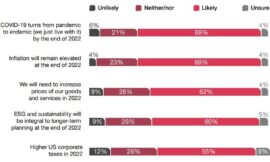A report from Kong details areas of concern for IT decision makers as well as some potential solutions to the problems involved with innovation.

A new study has found that decision-makers in the tech industry are fearful of their companies being an afterthought if they don’t remain on the cutting edge of technology. A 500-person survey as part of Kong’s 2022 API & Microservices Connectivity Report discovered that 75% of technology leaders fear competitive displacement if they fail to keep pace with digital innovation. The number is an increase of 13% from the year prior, signaling an increase in pressure to always be at the forefront of advanced tech.
“Kong’s latest API & Microservices Connectivity Report sheds critical insights into the state of business innovation and technology adoption as we enter this new post-pandemic era,” said Marco Palladino, chief technology officer and co-founder of Kong Inc. “We are in a unique business climate today where almost every minute of our customers’ lives are digitally connected, and they expect nothing less than seamless connections and the best digital experiences possible. Businesses must make customer experiences a priority in 2022 – starting by investing in the right tech stack and empowering their developer teams to build the applications of the future.”
SEE: Google Workspace vs. Microsoft 365: A side-by-side analysis w/checklist (TechRepublic Premium)
Ripple effects in lack of innovation
Even with many organizations making digital transformation a priority in the wake of the COVID-19 pandemic, many are worried that if innovation falls behind, the setback when combined with a lack of talent could strike a huge blow to their enterprise. Of those surveyed, 34% said an inadequate number of employees with the requisite skills is a huge concern and can stifle modernization within a company.
Going even further, it is estimated that many in tech decision-maker positions believe that if this creativity continues to falter, it may mean the end of the company altogether. Forty percent of the IT executive respondents said they think if innovation lags, they will be out of business or acquired by a competing company in three years time. If extended to a six-year timeframe, 81% said they believed being bought or defunct would happen if the enterprise was to fall behind on advancements, and 98% said this would happen if continued for a decade. These numbers signal that many in C-level positions are concerned about the strides their companies are making in comparison to competitors in the same markets.
Ways to prevent stagnation of new ideas
Kong, as part of the report, put forth a few different ways to keep innovation strong within businesses, namely:
- Proper IT budgets and funding
- Application programming interfaces (APIs) and modern software
- Leading digital experiences
The most important way enterprises can make sure they remain on the leading edge of innovation is investing in skilled workers and making digital tools accessible to the workforce. Of those surveyed, 79% said they expect their organizations to increase the IT and developer budgets by as much as 25% in the year ahead. Fifteen percent said they expect their budgets in the IT and development arenas to increase by half in 2022 as well. By allocating more resources and skilled workers towards these areas, it will allow businesses to constantly be pushing in favor of digital modernization and not allowing these organizations to fall behind competitors.
SEE: Top keyboard shortcuts you need to know (free PDF) (TechRepublic)
The use of APIs and the most up-to-date software was also cited as a way to prioritize digital experiences, through a reliable, secure and scalable tech stack. Nearly 90% of respondents said they believe that microservices-based applications are the future and the ability to support distributed applications is critical for success. These microservices allow for the rapid, frequent and reliable delivery of large, complex applications. The use of APIs for these microservices is also mentioned as a way for businesses to stay ahead of the competition, allowing enterprises to handle microservices at scale.
Innovating at a quick pace is another way organizations can stay competitive in their respective fields, but must be balanced against the potential deficiencies in security, performance and reliability. The technology leaders surveyed indicated that application security, improved performance, easy adoption of new technologies and improved developer efficiency were some of the top priorities when creating leading digital experiences. Finding the right balance between innovating technology, while keeping the workforce secure and efficient has to be a key area for businesses looking to stay at the forefront of their respective areas and avoid falling behind.
Source of Article



